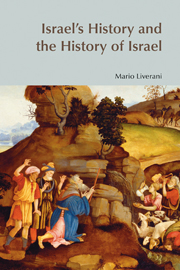Book contents
- Frontmatter
- Dedication
- Contents
- List of Tables and Illustrations
- Foreword
- Abbreviations
- IMPRINTING
- Part I A NORMAL HISTORY
- Chapter 2 THE TRANSITION (TWELFTH CENTURY)
- Chapter 3 THE NEW SOCIETY (c. 1150–1050)
- Chapter 4 THE FORMATIVE PROCESS (c. 1050–930)
- Chapter 5 THE KINGDOM OF ISRAEL (c. 930–740)
- Chapter 6 THE KINGDOM OF JUDAH (c. 930–720)
- Chapter 7 THE IMPACT OF THE ASSYRIAN EMPIRE (c. 740–640)
- Chapter 8 PAUSE BETWEEN TWO EMPIRES (c. 640–610)
- Chapter 9 THE IMPACT OF THE BABYLONIAN EMPIRE (c. 610–585)
- INTERMEZZO
- Part II AN INVENTED HISTORY
- EPILOGUE
- Bibliography
- Index of References
- Index of Names of Persons and Deities
- Index of Placenames
Chapter 7 - THE IMPACT OF THE ASSYRIAN EMPIRE (c. 740–640)
from Part I - A NORMAL HISTORY
- Frontmatter
- Dedication
- Contents
- List of Tables and Illustrations
- Foreword
- Abbreviations
- IMPRINTING
- Part I A NORMAL HISTORY
- Chapter 2 THE TRANSITION (TWELFTH CENTURY)
- Chapter 3 THE NEW SOCIETY (c. 1150–1050)
- Chapter 4 THE FORMATIVE PROCESS (c. 1050–930)
- Chapter 5 THE KINGDOM OF ISRAEL (c. 930–740)
- Chapter 6 THE KINGDOM OF JUDAH (c. 930–720)
- Chapter 7 THE IMPACT OF THE ASSYRIAN EMPIRE (c. 740–640)
- Chapter 8 PAUSE BETWEEN TWO EMPIRES (c. 640–610)
- Chapter 9 THE IMPACT OF THE BABYLONIAN EMPIRE (c. 610–585)
- INTERMEZZO
- Part II AN INVENTED HISTORY
- EPILOGUE
- Bibliography
- Index of References
- Index of Names of Persons and Deities
- Index of Placenames
Summary
The Conquest of the North
The lengthy independence of the states in the Levant that had begun around 1150 (when the ‘Sea Peoples’ had broken Hittite domination in the north and Egyptian control in the south) was about to be ended in the mid-eighth century by the Assyrians. The first phase of Assyrian intervention had already occurred in the second half of the ninth century. After Ashurnasirpal II (883–859) had united Assyria within its traditional borders, as far as the Middle Euphrates, the first phase of expansion was undertaken by Shalmaneser III (858–824) who conducted several campaigns against Damascus, Hamath and other Syro-Palestinian states, among them Israel, including the famous event of the battle of Qarqar (853) in which Ahab took part with a vast army (RIMA, III, 23). In 841 Jehu paid a tribute to Shalmaneser III (RIMA, III, 48), and again around 800 Jehoash paid a tribute to Adad-Nirari III (RIMA, III, 211). During this whole phase, Assyria did not move to any direct annexation, but imposed a payment of tribute to many Syrian states. Actual territorial expansion slowed down, postponed by a ‘feudal’ change in the structure of the empire, in which some high officials undertook virtually autonomous control over large areas. In the first half of the eighth century Assyrian intervention beyond the Euphrates became quite rare.
- Type
- Chapter
- Information
- Israel's History and the History of Israel , pp. 143 - 164Publisher: Acumen PublishingPrint publication year: 2005



